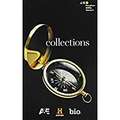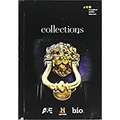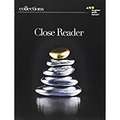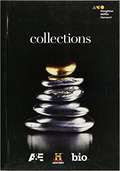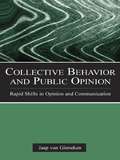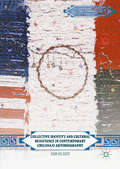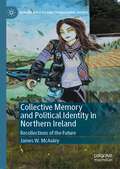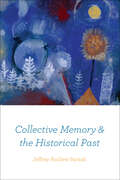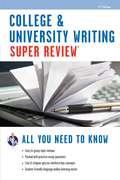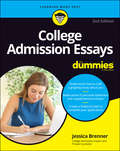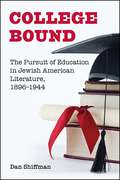- Table View
- List View
Collections Grade 8
by Kylene Beers Lydia Stack Carol Jago Martha Hougen William L. Mcbride Erik Palmer8th Grade Literature Textbook
Collections - Close Reader (Grade #10)
by Holt McdougalHoughton Mifflin Harcourt Collections - Close Reader, Grade 10
Collections: Close Reader (Student Edition) (Grade #6)
by Holt McdougalThe Houghton Mifflin Harcourt Collections program is a Grades 6-12 literature textbook series that is a comprehensive resource for addressing all expectations of the Common Core State Standards for English Language Arts. Rich, engaging, and complex texts are the program's anchor -- challenging and supporting all students to become critical and close readers. The program fosters success in writing across varied genres through models of effective writing and provides ample opportunities for speaking and writing about texts.
Collections: Pathways to Adventure (Grade #5)
by Harcourt School Publishers StaffPathways In Adventure: collated stories developed in the minds of imaginative writers and adventures experienced by real people in real places.
Collections: Times Of Discovery
by Harcourt School Publishers StaffA Reading and Language Arts textbook
Collective Behavior and Public Opinion: Rapid Shifts in Opinion and Communication (European Institute for the Media Series)
by Jaap van GinnekenThis is a highly innovative and stimulating work with the outline of an entirely new approach to massive and rapid shifts in opinion and communication. It discusses and explains such mysterious phenomena as sudden crazes and crashes, fads and fashion, hypes and manias, moral outrage and protests, gossip and rumors, and scares and panics. Rich in alternative insights, the book is divided into four parts. Part I discusses the points of departure: the most relevant processes of opinion formation and communication. Part II is about phenomena on three different levels, that have traditionally been studied within the twin fields of mass psychology and collective behavior sociology. Part III focuses on the three prime forms of "emotional coloring" of opinion currents and public moods. Part IV discusses a combination of some of the aforementioned phenomena: successive crazes and crashes in financial markets, and looks at why technological and economic, and social and opinion forecasts often fail so miserably. The audience for this book includes students of social and mass psychology, social movements and collective behavior sociology, and opinion and communication in general. Professionals in public relations, marketing, health, finance, and politics, as well as the educated lay audience, will also find this book of interest.
Collective Identity and Cultural Resistance in Contemporary Chicana/o Autobiography (Literatures of the Americas)
by Juan VelascoThe first book length study of this genre, Collective Identity and Cultural Resistance in Contemporary Chicana/o Autobiography facilitates new understandings of how people and cultures are displaced and reinvent themselves. Through the examination of visual arts and literature, Juan Velasco analyzes the space for self-expression that gave way to a new paradigm in contemporary Chicana/o autobiography. By bringing together self-representation with complex theoretical work around culture, ethnicity, race, gender, sex, and nationality, this work is at the crossroads of intersectional analysis and engages with scholarship on the creation of cross-border communities, the liberatory dimensions of cultural survival, and the reclaiming of new art fashioned against the mechanisms of violence that Mexican-Americans have endured.
Collective Memory Narratives in Contemporary Culture
by Emiliana Mangone Antonella Pocecco Estrella GualdaStarting from the central importance of memory in contemporary societies, this book encourages a transdisciplinary reflection on how the “presentification of the past” is never a simple reenactment but corresponds to the interaction between memory and cultural sensitiveness, present beliefs and needs, expectations, and forecasts for the future. It studies cultural (re)construction through collective stories, including academic debates, media narratives, collective mobilizations, state narratives of history, architectural reconstructions, and artistic expressions. It looks at how technological innovations have profoundly changed the practices of conservation and dissemination of collective memory, with particular reference to cultural digitization. Finally, it shows that the relevance and selection of events, the organization of connections and cross-references between past, present, and future, as well as the importance of diversified collective imaginaries are the keys to narrative constructions of memory that prove to be sensitive and decisive for its continuity and its intergenerational transmission. This interdisciplinary collection is for students and scholars of the social sciences, cultural studies, and the humanities interested in memory studies.
Collective Memory and Political Identity in Northern Ireland: Recollections of the Future (Memory Politics and Transitional Justice)
by James W. McAuleyThis book covers the notion of collective memory – broadly defined as the ways in which differing pasts are created, understood and reproduced – and how this is perpetuated in Northern Ireland by a wide set of social actors, including nations, religious and political groupings, and local communities. Such collective memories are not a preservative for historically accurate recall of bygone events but rather readings of the past subject to contemporary interpretations and political pressure. The adoption of political symbolism remains central to subsequent events. Indeed, in Northern Ireland, both communities hold their conflicting ‘memories’ dear and, importantly, rival political organizations have invested much in their own reading of the causes of the outbreak and continuation of the conflict. Set alongside constant exposure to other forms of discourse, texts, songs, prose and more visible physical manifestations – such as murals, commemorative gardens, personal tattoos, and even gravestones – there are a multitude of ways of reminding people of particular memories, community histories and interpretations of events, and of providing the background within which attitudes are formed.
Collective Memory and the Historical Past
by Jeffrey Andrew BarashThere is one critical way we honor great tragedies: by never forgetting. Collective remembrance is as old as human society itself, serving as an important source of social cohesion, yet as Jeffrey Andrew Barash shows in this book, it has served novel roles in a modern era otherwise characterized by discontinuity and dislocation. Drawing on recent theoretical explorations of collective memory, he elaborates an important new philosophical basis for it, one that unveils important limitations to its scope in relation to the historical past. Crucial to Barash's analysis is a look at the radical transformations that the symbolic configurations of collective memory have undergone with the rise of new technologies of mass communication. He provocatively demonstrates how such technologies' capacity to simulate direct experience--especially via the image--actually makes more palpable collective memory's limitations and the opacity of the historical past, which always lies beyond the reach of living memory. Thwarting skepticism, however, he eventually looks to literature--specifically writers such as Marcel Proust, Walter Scott, and W. G. Sebald--to uncover subtle nuances of temporality that might offer inconspicuous emblems of a past historical reality.
College & University Writing Super Review (Super Reviews Study Guides)
by Della Ata KhouryREA's College & University Writing Super Review Get all you need to know with Super Reviews! 2nd Edition REA's College & University Writing Super Review contains an in-depth review that fully explains everything high school and college students need to know about the subject. Written in an easy-to-read format, this study guide is an excellent refresher and helps students grasp the important elements quickly and effectively. Our Super Review can be used as a companion to high school and college textbooks or as a handy resource for anyone who wants to improve their writing skills and needs a fast review of the subject. Presented in a straightforward style, our review covers what all students need to know to write at a college level: the writing process, basic composition, pre-writing, outlining, researching, drafting, editing, and writing about literature. The book includes questions and answers to help reinforce what students learned from the review. Quizzes on each topic help students increase their knowledge and understanding.
College Admission Essays For Dummies
by Geraldine Woods Jessica BrennerCollege is supposed to be fun, remember? Take the stress out of the admissions process with expert advice on writing personal essays. College can be an absolute blast. But making it into your dream school is no easy feat. Don’t be intimidated—College Admission Essays For Dummies is here to alleviate your anxieties and help you craft an unforgettable personal essay with the potential to impress any admissions committee. This helpful guide walks you through every step of the writing process, from brainstorming and prep to the final polishes and submission. You’ll learn how to make your essay stand out from the ocean of other applicants and get your personality to pop off the page. In addition to stellar examples of essays that got their writers into their first-choice schools, you’ll get the inside scoop on how to: Use writing to transform you from a statistic into a compelling and attractive candidate Illustrate who you are through vivid storytelling and self-reflection Deal with writer’s block and essay anxiety to get the most out of your time Learn about the most common question types and get your admissions officer’s attention with your short answers With colleges around the country beginning to discount the impact of SAT and ACT scores, the personal essay is more important than ever. College Admission Essays For Dummies is the up-to-date roadmap you need to navigate your way to the perfect college essay.
College Bound: The Pursuit of Education in Jewish American Literature, 1896-1944 (SUNY series in Contemporary Jewish Literature and Culture)
by Dan ShiffmanJewish American immigrants and their children have been stereotyped as exceptional educational achievers, with attendance at prestigious universities leading directly to professional success. In College Bound, Dan Shiffman uses literary accounts to show that American Jews' relationship with education was in fact far more complex. Jews expected book learning to bring personal fulfillment and self-transformation, but the reality of public schools and universities often fell short. Shiffman examines a wide range of novels and autobiographies by first- and second-generation writers, including Abraham Cahan, Mary Antin, Anzia Yezierska, Elizabeth Gertrude Stern, Ludwig Lewisohn, Marcus Eli Ravage, Lionel Trilling, and Leo Rosten. Their visions of learning as a process of critical questioning—enlivening the mind, interrogating cultural standards, and confronting social injustices—present a valuable challenge to today's emphasis on narrowly measurable outcomes of student achievement.
College Essay Essentials: A Step-by-Step Guide to Writing a Successful College Admissions Essay
by Ethan SawyerWriting an amazing college admission essay is easier than you think!So you're a high school senior given the task of writing a 650-word personal statement for your college application. Do you tell the story of your life, or a story from your life? Do you choose a single moment? If so, which one? The options seem endless.Lucky for you, they're not. College counselor Ethan Sawyer (aka The College Essay Guy) will show you that there are only four (really, four!) types of college admission essays. And all you have to do to figure out which type is best for you is answer two simple questions:1. Have you experienced significant challenges in your life? 2. Do you know what you want to be or do in the future?With these questions providing the building blocks for your essay, Sawyer guides you through the rest of the process, from choosing a structure to revising your essay, and answers the big questions that have probably been keeping you up at night: How do I brag in a way that doesn't sound like bragging? and How do I make my essay, like, deep?Packed with tips, tricks, exercises, and sample essays from real students who got into their dream schools, College Essay Essentials is the only college essay guide to make this complicated process logical, simple, and (dare we say it?) a little bit fun.
College Essays That Made a Difference, 6th Edition
by Princeton ReviewNo one knows colleges better than The Princeton Review!Not sure how to tackle the scariest part of your college application--the personal essays? Get a little inspiration from real-life examples of successful essays that scored! In College Essays That Made a Difference, 6th Edition, you'll find:* More than 100 real essays written by 90 unique college hopefuls applying to Harvard, Stanford, Yale, and other top schools--along with their stats and where they ultimately got in* Tips and advice on avoiding common grammatical mistakes* Q&A with admissions pros from 20 top colleges, including Connecticut College, Cooper Union, The University of Chicago, and many moreThis 6th edition includes application essays written by students who enrolled at the following colleges:Amherst CollegeBarnard CollegeBrown UniversityBucknell UniversityCalifornia Institute of TechnologyClaremont McKenna CollegeCornell UniversityDartmouth CollegeDuke UniversityGeorgetown UniversityHarvard CollegeMassachusetts Institute of TechnologyNorthwestern UniversityPomona CollegePrinceton UniversitySmith CollegeStanford UniversitySwarthmore CollegeWellesley CollegeWesleyan UniversityYale UniversityFrom the Trade Paperback edition.
College Essays That Made a Difference, 6th Edition
by Princeton ReviewNo one knows colleges better than The Princeton Review!Not sure how to tackle the scariest part of your college application—the personal essays? Get a little inspiration from real-life examples of successful essays that scored! In College Essays That Made a Difference, 6th Edition, you’ll find:• More than 100 real essays written by 90 unique college hopefuls applying to Harvard, Stanford, Yale, and other top schools—along with their stats and where they ultimately got in• Tips and advice on avoiding common grammatical mistakes• Q&A with admissions pros from 20 top colleges, including Connecticut College, Cooper Union, The University of Chicago, and many moreThis 6th edition includes application essays written by students who enrolled at the following colleges:Amherst CollegeBarnard CollegeBrown UniversityBucknell UniversityCalifornia Institute of TechnologyClaremont McKenna CollegeCornell UniversityDartmouth CollegeDuke UniversityGeorgetown UniversityHarvard CollegeMassachusetts Institute of TechnologyNorthwestern UniversityPomona CollegePrinceton UniversitySmith CollegeStanford UniversitySwarthmore CollegeWellesley CollegeWesleyan UniversityYale UniversityFrom the Trade Paperback edition.
